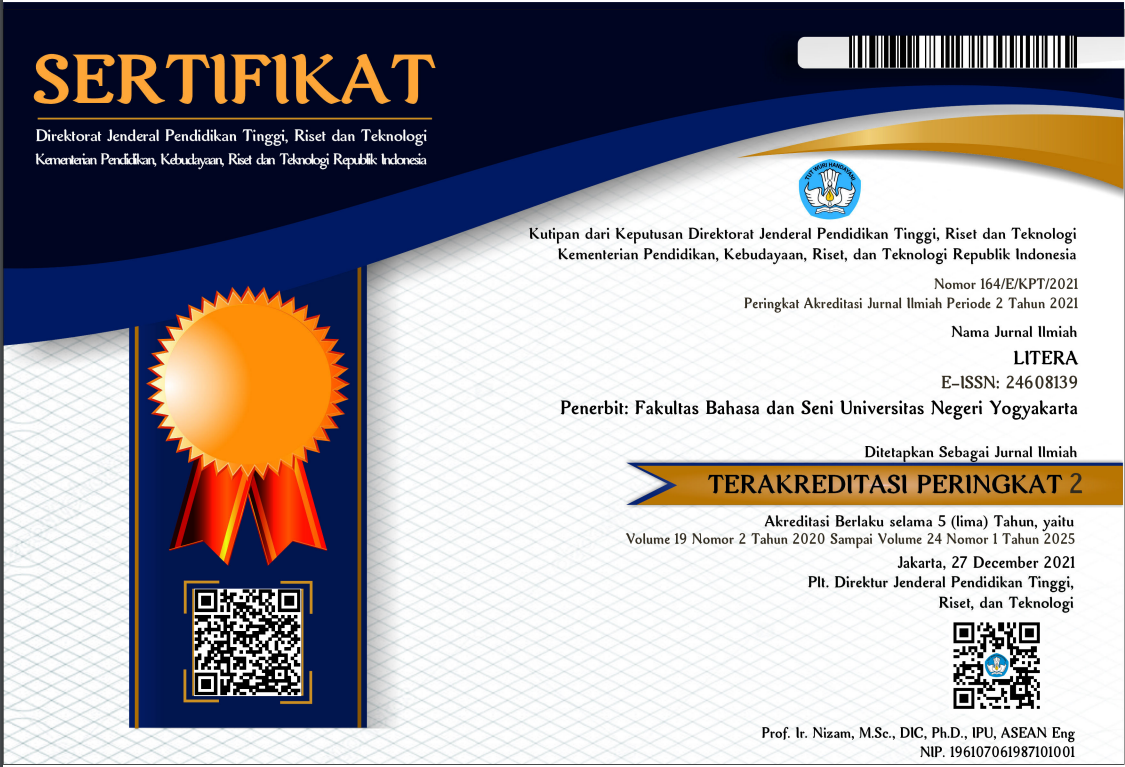Portrait of Indonesian language communication in the marginalized communities of the north coast of Central Java
Downloads
Indonesian, as the national language, plays an important role in communication throughout Indonesia, but its use in marginalized communities on the north coast of Central Java has rarely been studied. These communities consist of fishermen, small traders and low-income people who face social, cultural and economic challenges. This study aims to examine how they use Indonesian in their daily lives, the factors that influence them, such as local dialect, education level, and socio-economic conditions, as well as the impact of modernization on their language practices. The method used is descriptive qualitative with observation, interview, and documentation. A total of 193 respondents were involved, showing variations in language use based on education, gender, and social status. It was found that language practices reflect people's identity and survival strategies. The main focus of this research is the form and function of Indonesian language communication in reflecting the identity, adaptation, and resilience of marginalized communities in the midst of limitations.
Downloads
Adawiyah, R., & Hasanah, M. (2020). Melawan stigma inferioritas perempuan: Kajian novel Midah (Si Manis Bergigi Emas) karya Pramoedya Ananta Toer dan novel Di Balik Kerling Saatirah karya Ninik M. Kuntarto. Litera, 19(3), 414–436. https://doi.org/10.21831/ltr.v19i3.35662
Alamsyah, B., Nuraini, C., Kuswandi, & Suwarno, B. (2022). Strategi manajemen mitigasi bencana pesisir Pantai Timur Sumatera Utara. Unpripress
Amelia, Y. (2023). Peran kebudayaan dalam pembentukan kesadaran sosial dan lingkungan. Jurnal Pendidikan Sosial Indonesia, 1(1), 9–18. https://doi.org/https://doi.org/10.62238/jupsi.v1i1.94
Ammaria, H. (2017). Komunikasi dan budaya. Jurnal Peurawi: Media kajian komunikasi Islam, 1(1), 1–19. http://doi.org/10.22373/jp.v1i1.1992
Anindya, A., & Lokita, R. A. M. (2023). Tantangan dan peluang dalam mengembangkan komunikasi lingkungan yang efektif di era digital. Jurnal Fateksa: Jurnal Teknologi dan Rekayasa, 8(1), 25–37
Baker, C. (2011). Foundations of bilingual education and bilingualism (5th ed.). Multilingual Matters
Bulan, D. R. (2019). Bahasa Indonesia sebagai identitas nasional bangsa Indonesia. JISIPOL: Jurnal Ilmu Sosial dan Politik, 3(2), 23–29. https://ejournal.unibba.ac.id/index.php/jisipol/article/view/115
Chotim, E. R., & Latifah, S. U. (2018). Komunitas anak punk dan anomali sosial (Studi kasus di kecamatan Ujung Beruang kota Bandung). JISPO: Jurnal Ilmu Sosial dan Politik, 8(1), 69–93. https://doi.org/https://doi.org/10.15575/jp.v8i1.2772
Daud, R. F. (2021). Dampak perkembangan teknologi komunikasi terhadap bahasa Indonesia. Jurnal Interaksi: Jurnal Ilmu Komunikasi, 5(2), 252-269. https://doi.org/10.30596/interaksi.v5i2.7539
Eckert, P., & McConnell-Ginet, S. (2013). Language and gender. Cambridge University Press. https://doi.org/10.1017/CBO9781139245883
Fajrie, M. (2018). Gaya komunikasi masyarakat pesisir wedung Jawa Tengah. INJECT (Interdisciplinary Journal of Communication), 2(1), 53. https://doi.org/10.18326/inject.v2i1.53-76
Fathiyyah, N. J., Putri, A. K. S., Nada, A. K., Sanggreni, A. D., Wulandari, A., & Yulianingsih, D. (2024). Persepsi mahasiswa baru Sastra Jawa angkatan 2023 terhadap bahasa Ngapak di Fakultas Bahasa dan Seni Universitas Negeri Semarang. Jurnal Kultur, 3(2), 150–162. http://jurnalilmiah.org/journal/index.php/kultur
Guerra-Carrillo, B., Katovich, K., & Bunge, S. A. (2017). Does higher education hone cognitive functioning and learning efficacy? Findings from a large and diverse sample. PLOS ONE, 12(8), e0182276. https://doi.org/10.1371/journal.pone.0182276
Husin, H., & Hatmiati, H. (2018). Budaya dalam penerjemahan bahasa. Al Mi’yar: Jurnal Ilmiah Pembelajaran Bahasa Arab dan Kebahasaaraban, 1(2), 39. https://doi.org/10.35931/am.v1i2.43
Ilham, L., & Farid, A. (2019). Kebahagiaan dalam perspektif masyarakat marjinal (Studi masyarakat desa Hadipolo Argopuro Kudus Jawa Tengah). Jurnal Ilmiah Sosiologi Agama dan Perubahan Sosial, 13(2), 95-124. https://doi.org/10.14421/|JSA
Li, D. (2022). A review of academic literacy research development: From 2002 to 2019. Asian-Pacific Journal of Second and Foreign Language Education, 7(1), 5. https://doi.org/10.1186/s40862-022-00130-z
Lutfianti, F. A., Ripai, A., Muhajir, & Suciati, S. (2024). Dampak penggunaan bahasa Indonesia pada keluarga marginal di Brebes. Jurnal Pendidikan Bahasa dan Sastra Indonesia, 9(2), 112–115. http://doi.org/10.26737/jp-bsi.v9i2.5445
Mukramin, S. (2018). Strategi bertahan hidup: Masyarakat pesisir suku Bajo di kabupaten Kolaka Utara. Walasuji: Jurnal Sejarah dan Budaya, 9(1), 175–186. https://doi.org/10.36869/wjsb.v9i1.29
Muktadir, A., Susanti, A., Darmansyah, A., Febrina, W., & Irmayanti, M. (2024). Problem-based learning: Making caricature as teaching material based on folklore “Sang Piatu” for Indonesian language learning. Litera, 23(2), 210–223. https://doi.org/10.21831/ltr.v23i2.72541
Namira, A., Setia, E., Mono, U., Rangkuti, R., & Fithriani, R. (2024). Attitude in disaster reports in Indonesian newspaper: A critical discourse analysis. Litera, 23(2), 165–178. https://doi.org/10.21831/ltr.v23i2.71386
Nursalam, Akhiruddin, & M. Ridwan. (2022). Representasi gender dan aspek pendukung kemampuan bilingualisme penutur bahasa Makassar di Ambon. Jurnal Onoma: Pendidikan, Bahasa, dan Sastra, 8(2), 738–748. https://doi.org/10.30605/onoma.v8i2.1977
Purnamasari, A., & Hartono, W. J. (2023). Pentingnya penggunaan bahasa Indonesia di perguruan tinggi. Jotika Journal in Education, 2(2), 57–64. https://doi.org/https://doi.org/10.56445/jje.v2i2.84
Rahayu, W. (2023). Penggunaan dan pemaknaan bahasa Indonesia pada era globalisasi. Jurnal Penelitian Multidisiplin, 2(1), 158–162. https://doi.org/10.58705/jpm.v2i1.117
Rosana, E. (2017). Dinamisasi kebudayaan dalam realitas sosial. Al-Adyan: Jurnal Studi Lintas Agama, 12(1), 16–30. https://doi.org/10.24042/ajsla.v12i1.1442
Sianturi, H. A., Pardede, E. F., Sebayang, T. S., & Siregar, M. W. (2024). Wacana kritis: Sebuah analisis terhadap penggunaan bahasa dalam konteks politik. JICN: Jurnal Intelek dan Cendikiawan Nusantara, 1(3), 3644–3654. https://jicnusantara.com/index.php/jicn
Sirait, Z., & Maulana, C. (2021). Analisis penggunaan bahasa Indonesia pada konteks percakapan iklan komersil di radio. JBSI: Jurnal Bahasa dan Sastra Indonesia, 1(01), 56–64. https://doi.org/10.47709/jbsi.v1i01.1232
Sulistiyono, S. T. (2014). Mengenal sistem pengetahuan, teknologi, dan ekonomi nelayan Pantai Utara Jawa. AGASTYA: Jurnal Sejarah dan Pembelajarannya, 4(2), 1–24. https://doi.org/10.25273/ajsp.v4i02.825
Sunaryo, T. (2019). Indonesia sebagai negara kepulauan. Jurnal Kajian Stratejik Ketahanan Nasional, 2(2), 97-105. http://jurnalpkn.ui.ac.id/index.php/jkskn/article/view/22
Suparlan, P. (2002). Menuju masyarakat Indonesia yang multikultural. Antropologi Indonesia, 98–105
Thohir, M. (2022). Masyarakat dan Budaya Jawa Pesisir Utara. ENDOGAMI: Jurnal Ilmiah Kajian Antropologi, 5(2), 123–128. https://doi.org/10.14710/endogami.5.2.123-128
Yahya, B., Sofa Marwah, Oktafiani Catur Pratiwi, & Wita Ramadhanti. (2023). Dinamika masyarakat Islam pesisir pantai utara Jawa. Prosiding Seminar Nasional LPPM Unsoed, 12, 63–70
Yu, Z. (2021). The effects of gender, educational level, and personality on online learning outcomes during the COVID-19 pandemic. International Journal of Educational Technology in Higher Education, 18(1), 14. https://doi.org/10.1186/s41239-021-00252-3
Copyright (c) 2025 Sri Suciati, Nazla Maharani Umaya

This work is licensed under a Creative Commons Attribution-ShareAlike 4.0 International License.

This work is licensed under a Creative Commons Attribution-ShareAlike 4.0 International License.























